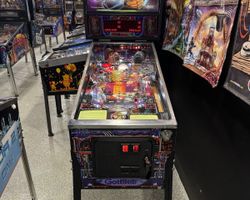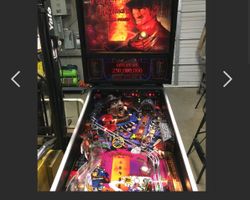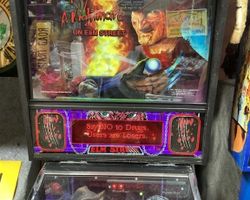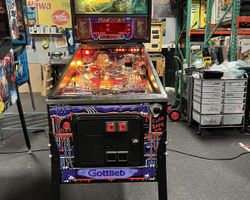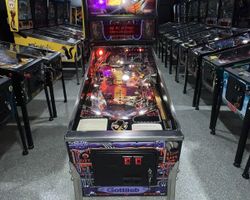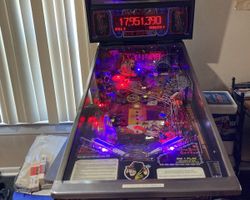Freddy: a Nightmare on Elm Street
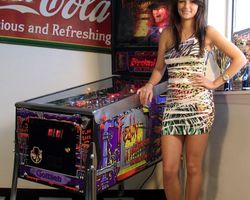
Average Prices: USD $500 to $3,000
Produced: October, 1994
Production Run: 2,800 units
Machine Type: Solid State Electronic
MPU: Gottlieb System 3
Players: 4
Design by: Ray Tanzer, Bill Parker
Art by: Constantino Mitchell
Sound by: Craig Beierwaltes, Duane Decker, Robert Englund
Software by: Allen Edwall, Alycen Hareas
The pinball machine Freddy: A Nightmare on Elm Street plunges players into the nightmarish world of Wes Craven's horror franchise, a mechanical adaptation of the iconic film series. Released in October 1994 by D. Gottlieb & Co., operating under the Premier Technology banner, this game carved out its niche in the competitive pinball landscape of the mid-1990s. Its creation marked a significant moment for Gottlieb, a company known for its long history in pinball manufacturing, as it continued to leverage popular culture licenses.
The machine's design was a collaborative effort. The playfield layout and gameplay were conceived by designers Bill Parker and Ray Tanzer, aiming to capture the sinister essence of Freddy Krueger's realm. Artwork, crucial for conveying the thematic dread, was brought to life by Constantino Mitchell and Jeanine Mitchell, who crafted the distinct backglass and cabinet visuals. The auditory experience was handled by Duane Decker, who composed the music, and Craig Beierwaltes, responsible for the chilling sound design. Crucially, the machine features custom speech, including voice work by Robert Englund himself, the actor who defined Freddy Krueger, lending unparalleled authenticity to the game's atmosphere. Software and animation, vital for the machine's interactive elements and display visuals, were developed by Allen Edwall, Alycen Hareas, Jon Norris, Rand Paulin, Daryl Moore, and Vecennia Jordan. With a production run of 2,800 units, Freddy: A Nightmare on Elm Street stands as a tangible piece of pinball history from the Gottlieb System 3 generation, a platform known for its robust electronics.
Signature Features and Design
Freddy: A Nightmare on Elm Street distinguishes itself through a suite of unique mechanical and aesthetic features, all meticulously designed to immerse players in its horror theme. Central to the playfield is the animated Freddy Krueger head, a dominant toy that serves a dual purpose. Not only does its jaw move, enhancing Freddy's constant on-screen taunts, but it also physically spits out balls, initiating one of the game's exciting multiball phases. This interactive head is a core visual and mechanical highlight, directly connecting gameplay to the antagonist.
Another innovative feature is the "Claw Ball Save," a player-controlled up-post positioned between the bottom flippers. Activated by a dedicated third flipper button, this mechanism provides a tactical defense against draining balls, offering a momentary reprieve from Freddy's clutches. Complementing this is the "glove flipper," a smaller, occasional flipper located on an upper ramp, shaped distinctly like Freddy's razor-gloved hand. This unique flipper is used for specific skill shots, tying into the game's objectives and adding thematic flair. Further enhancing ball movement, a curved metal ball diverter redirects the traditional plunger lane, allowing balls to enter play mid-playfield, introducing an element of unpredictability from the outset. The detailed artwork by the Mitchells extends across the cabinet and backglass, faithfully rendering scenes and characters from the Nightmare on Elm Street universe. The integration of Robert Englund's voice ensures that Freddy's taunts and quips are authentic, constantly heckling the player and reinforcing the pervasive horror. These combined elements create a distinct experience that leverages the license beyond mere superficiality.
Playfield and Mechanics
The playfield of Freddy: A Nightmare on Elm Street is laid out to deliver a fast-paced, direct gameplay experience, characterized by specific interactive elements that reflect its theme. At the heart of the lower playfield lies a captive ball, a common target that can trigger various events or modes. Above this, a set of three drop targets, artfully designed as "rubber faces," represent victims or obstacles for the player to clear.
A primary shot on the playfield leads to the "boiler shot," a recurring target that frequently becomes a focal point for mode progression and scoring. This central shot, while critical, has been noted by some players for contributing to a degree of shot repetition. Adjacent to this, a "furnace target" provides another interactive element, reinforcing the theme of Freddy's boiler room lair. The upper playfield incorporates a "back diverter" that can redirect the ball from a loop shot, altering its trajectory and creating different shot opportunities. The aforementioned glove flipper on the upper ramp adds an additional layer of strategy, requiring precise timing for specific shots, including skill shots. The playfield's aesthetic, masterfully crafted by Constantino and Jeanine Mitchell, embraces a dark, atmospheric palette consistent with the horror theme. While this contributes to the immersive, eerie ambiance, it can result in a playfield that appears somewhat dim, a stylistic choice that players often augment with additional lighting. The overall design philosophy emphasizes direct engagement with major targets, fostering a high-energy game flow where players are constantly confronted by the challenges of Freddy's domain.
Gameplay Dynamics
The gameplay dynamics of Freddy: A Nightmare on Elm Street offer a straightforward yet engaging experience, built around quick action and thematic progression. The game’s ruleset is relatively simple, allowing players to quickly grasp objectives and immerse themselves in the horror. Progression often centers around hitting the boiler room shot, which can trigger different single-ball modes. These modes present specific objectives, albeit sometimes basic, keeping players focused on precise targets.
Multiball is a significant scoring opportunity and a frequent highlight. The game can feature up to four balls in play simultaneously, often starting with Freddy's animated head spitting them out. This chaotic frenzy is a primary avenue for accumulating high scores, demanding players manage multiple balls while aiming for valuable shots. Player strategies often revolve around consistently hitting the boiler room, mastering the timing for the "Claw Ball Save" to prevent drains, and capitalizing on multiball phases. While the "skill shots" utilizing the glove flipper are present, some players note they are not particularly challenging, making them less about precision and more about simple execution. Beyond the core modes, Freddy Krueger himself serves as a constant antagonist. His custom speech, delivered by Robert Englund, provides a stream of taunts and commentary throughout the game, creating a personalized, unsettling atmosphere that adds to player immersion. This continuous interaction enhances the feeling of battling Freddy, making each game a memorable encounter within his nightmare.
Reception and Legacy
The reception of Freddy: A Nightmare on Elm Street within the pinball community has been mixed, yet generally positive, securing its place as a distinct entry in the Gottlieb System 3 catalog. Many players express an appreciation for the machine's strong thematic integration. The artwork on the backglass and cabinet, the compelling sound effects, the music, and particularly the authentic callouts from Robert Englund's Freddy Krueger are frequently cited as highlights, creating a genuinely creepy and fun atmosphere. The game's unique mechanical toys, such as Freddy's head that dispenses balls, the strategically useful "Claw Ball Save," and the thematic "glove flipper," are also well-regarded for adding depth and novelty to the play experience. Its fast-paced gameplay and approachable ruleset make it enjoyable for both casual players and those new to the hobby, with the multiball action often highlighted as a significant source of excitement. For fans of the Nightmare on Elm Street franchise, the machine holds considerable collectible appeal, serving as a tangible piece of horror cinema history. Furthermore, the inherent reliability of Gottlieb System 3 machines often garners positive remarks.
However, the machine is not without its criticisms. A common point of contention is the potential for gameplay repetition, with many shots funneling players towards the boiler room, leading to modes that some find too basic or lacking in variety. The playfield layout itself has drawn some criticism, with observations of a somewhat "clunky" feel and a perceived lack of ramps compared to contemporaries. Concerns regarding build quality, particularly the fragility of the glove flipper's fingers, have been noted, alongside some general reliability issues. The dim lighting on the playfield, while contributing to the horror ambiance, is sometimes seen as a detriment to visibility. Despite these points, Freddy: A Nightmare on Elm Street maintains a notable reputation. It stands as an example of a successful licensed horror pinball machine, showcasing Gottlieb's efforts to blend unique mechanical features with popular themes. Its enduring presence in collections and its continued discussion among enthusiasts underscore its significance as a distinctive and memorable machine from the mid-90s pinball era.
Sponsored Links
 Ebay Listings
Ebay Listings
 Auction Results
Auction Results
| Cost | Location | Date |
|---|---|---|
| USD $6,299 |  California, United States California, United States |
28 September, 2025 |
| USD $4,200 |  California, United States California, United States |
27 June, 2025 |
| USD $4,250 |  Florida, United States Florida, United States |
24 May, 2025 |
| AUD $6,000 |  Western Australia, Australia Western Australia, Australia |
27 February, 2025 |
| USD $4,989 |  Florida, United States Florida, United States |
08 September, 2024 |
| USD $5,999 |  California, United States California, United States |
16 April, 2024 |
| USD $3,000 |  Minnesota, United States Minnesota, United States |
12 April, 2024 |
| USD $4,500 |  Florida, United States Florida, United States |
29 March, 2024 |
| USD $4,200 |  Florida, United States Florida, United States |
23 March, 2024 |
| EUR €4,650 |  Baden-Württemberg, Germany Baden-Württemberg, Germany |
11 September, 2023 |


Private Policy · Search Website · Contact Us
As an eBay Partner, we may earn a commission from qualifying purchases made through links on this site, at no additional cost to you.
All trademarks and copyrighted materials remain property of their respective owners. All other content copyright 2007 - 2025 Pinpedia.

